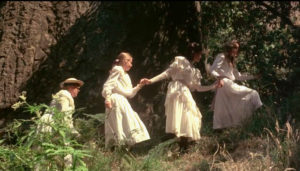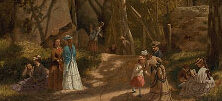Ironically, the picnic at Hanging Rock overpowers the narrative though it is the novel’s shortest section. The events and ambiance are so actual that readers accept the narrative at face value. Lindsay helped set this delusion by suggesting, “Whether Picnic at Hanging Rock is Fact or Fiction, my readers must decide for themselves.” Eventually revealed as fiction, and that clever publisher cut Lindsay’s final chapter explaining the mystery, readers preferred the illusion to reality.
The day picnic food is ordinary. Except for the tepid bananas that Lindsay considers an Australian picnic staple, there are chicken pot pies, angel cakes, jellies, and, because it is Saint Valentine’s Day, iced cake in the shape of a heart.
“Everyone agreed that the day was just right for the picnic to Hanging Rock,” Lindsay writes, “a shimmering summer morning warm and still, with cicadas shrilling.” The excursion begins well for the nineteen coeds, dressed in white, like vestal virgins, on some perfect adventure. But there are signs of foreshadowing mishap, if not disaster. Of course, the omens are not noted until after, and it’s too late that two girls and a teacher have gone missing.
Before leaving Appleyard College, Mrs. Appleyard instructs the girls to be careful and wary of venomous snakes and poisonous ants. Afterward, you can follow a trail of negativity; a long three-hour wagon ride, rising summer heat, and stopped watches. The picnic grounds have the vague look of a ruined temple, rings of stones, and a Japanese pagoda (that’s a privy). Edith notices the queerness of the place because it is so quiet. Over two thousand feet high, the rocks have a primordial look like smooth giant tombstones. Creepiest is one, especially a “single pock-marked stone” that resembles “a monstrous egg.” the girls climbing the rocks, Miranda, Irma, Marion, and Edith, have no path to follow in a trance. The closer they get to the summit, the more they appear to be in a time warp.

So they climbed. Edith (Christine Schuler) Marion (Jane Vallis), Miranda ( Anne-Louise Lambert), and Irma Karen Robson)
See Joan Lindsay. Picnic at Hanging Rock. Melbourne: F. W. Cheshire, 1967; The Secret of Picnic at Hanging Rock: Joan Lindsay’s Final Chapter, Edited by Yvonne Rousseau (Sydney: Angus and Paulson, 1987); William Ford. At the Hanging Rock, Near Mount Macedon (1875). Oil on canvas. National Gallery Victoria, Melbourne; Peter Weir. Picnic at Hanging (1975). Screenplay by Cliff Green is based on Rachel Lindsay’s novel; (1967); Michael Rymer, Larysa Kondracki, Amanda Brotchie (2018). Picnic at Hanging Rock. The screenplay by Beatrix Christian and Alice Addison is based on Lindsay’s novel; Larysa Kondracki. Picnic at Hanging Rock, Episode One, Two, Three, (2018). The screenplay by Beatrix Christian is based on Joan Lindsay’s novel and Peter Weir’s film.
Featured Image: William Ford. At the Hanging Rock, Near Mount Macedon (1875). Oil on canvas. National Gallery Victoria

